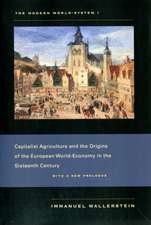The European Renaissance in American Life
Autor Paul F. Grendleren Limba Engleză Hardback – 29 mar 2006 – vârsta până la 17 ani
Preț: 359.89 lei
Preț vechi: 436.63 lei
-18% Nou
Puncte Express: 540
Preț estimativ în valută:
68.86€ • 71.91$ • 56.87£
68.86€ • 71.91$ • 56.87£
Carte tipărită la comandă
Livrare economică 16-30 aprilie
Preluare comenzi: 021 569.72.76
Specificații
ISBN-13: 9780275984861
ISBN-10: 0275984869
Pagini: 360
Dimensiuni: 156 x 235 x 33 mm
Greutate: 0.71 kg
Editura: Bloomsbury Publishing
Colecția Praeger
Locul publicării:New York, United States
ISBN-10: 0275984869
Pagini: 360
Dimensiuni: 156 x 235 x 33 mm
Greutate: 0.71 kg
Editura: Bloomsbury Publishing
Colecția Praeger
Locul publicării:New York, United States
Notă biografică
Paul F. Grendler is a distinguished scholar of the Italian Renaissance. The author of numerous books and editor in chief of Encyclopedia of the Renaissance and Renaissance: An Encyclopedia for Students, he has been president of three scholarly organizations including The Renaissance Society of America. He is currently a Fellow of the American Philosophical Society. Grendler taught at the University of Toronto for thirty-four years.
Recenzii
Intended for a general audience, this book examines how the term Renaissance is used in modern US culture and why it remains so popular with the general public. Grendler draws upon decades of experience as a professor, author, and editor to gently point out ways in which Michelangelo, Machiavelli, and the Medici are (mis)used by today's politicians, management gurus, filmmakers, and novelists. The introduction describes the real Renaissance as Grendler sees it (i.e., the movement from 1400 to 1620, beginning in Italy and celebrating achievements in art, education, poetry, and high culture), while the conclusion discusses the recent turn in the academy away from Renaissance in favor of early modern..Recommended. Public and undergraduate libraries.
The opening pages offer a concise, well-presented summary of the period 1400-1620.a prelude to the rest of the book. If a faculty member needed to introduce the period quickly, these pages would do that job well.
Americans like the Renaissance. So concludes distinguished Renaissance scholar Paul F. Grendler in this book every sholar should read. The European Renaissance in American Life is a work that in less sympathetic hands might have devolved into yet another satire of American middle-class, middle-brow, and middle-mind culture. In Grendler's hands, however, America's love affair with the Renaissance comes off as something more than whimsy, kitsch, or simple goofiness..[a]nd emerges as a challenge to those of us who toil daily at revealing, critiquing, deconstructing, or simply understanding the Renaissance..As far as it goes, Grendler's is a terrific book and a wonderful read.
For anyone wanting to be more observant and knowledgeable of the European Renaissance period's influence on today's society, this text is a wonderful read.
Paul Grendler's book examines how and why the famous figures and icons of Renaissance Italy and Renaissance England resonate so well outside the scholarly community. He works hard to point out ways in which these modern interpreters beyond the ivory tower have used, or misused, the principal ideas and achievements of this era..The book should be useful to lower-level undergraduates and to adult students, and it will be amusing and thought-provoking to faculty and graduate students.
Renaissance faires, costume parties, outdoor festivals, company names, Shakespeare movies, and a new love for the principles of Machiavelli are among the evidence American scholar of the Italian Renaissance Grendler cites for a renaissance of the Renaissance in the US over the past couple of decades. Before describing the recent incarnation, he summarizes the first Renaissance, from 1400-1620.
The opening pages offer a concise, well-presented summary of the period 1400-1620.a prelude to the rest of the book. If a faculty member needed to introduce the period quickly, these pages would do that job well.
Americans like the Renaissance. So concludes distinguished Renaissance scholar Paul F. Grendler in this book every sholar should read. The European Renaissance in American Life is a work that in less sympathetic hands might have devolved into yet another satire of American middle-class, middle-brow, and middle-mind culture. In Grendler's hands, however, America's love affair with the Renaissance comes off as something more than whimsy, kitsch, or simple goofiness..[a]nd emerges as a challenge to those of us who toil daily at revealing, critiquing, deconstructing, or simply understanding the Renaissance..As far as it goes, Grendler's is a terrific book and a wonderful read.
For anyone wanting to be more observant and knowledgeable of the European Renaissance period's influence on today's society, this text is a wonderful read.
Paul Grendler's book examines how and why the famous figures and icons of Renaissance Italy and Renaissance England resonate so well outside the scholarly community. He works hard to point out ways in which these modern interpreters beyond the ivory tower have used, or misused, the principal ideas and achievements of this era..The book should be useful to lower-level undergraduates and to adult students, and it will be amusing and thought-provoking to faculty and graduate students.
Renaissance faires, costume parties, outdoor festivals, company names, Shakespeare movies, and a new love for the principles of Machiavelli are among the evidence American scholar of the Italian Renaissance Grendler cites for a renaissance of the Renaissance in the US over the past couple of decades. Before describing the recent incarnation, he summarizes the first Renaissance, from 1400-1620.










